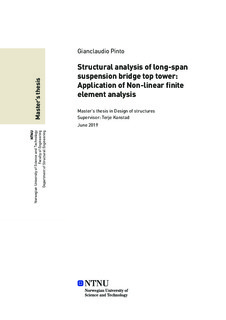| dc.description.abstract | The Norwegian Ministry of Transport and Communications has commissioned the Norwegian Public Roads Administration (NPRA) to explore a project on the Coastal Highway E39 along the Norwegian west coast.
This master thesis project analyse the case of the Hardanger Bridge which is a suspension bridge built in 2013: this case study is part of this vast and ambitious project which is not only a chance to turn Norway into a more developed nation, but it is also a technological challenge, in particular for what concern the fjords crossings.
In this thesis the top tower part of the Hardanger Bridge was analysed: starting from the design drawings provided by the “Staten Vegvesen”, the geometry of the top tower was built in CAD environment (Autocad and Rhino software) and, then, implemented within a finite element software Abaqus/CAE. The first part of the project consists of the definition of the material properties and the loads acting on the top tower, in particular on the steel saddle. The properties of each material were evaluated according to the actual Eurocode 2 – EN 1992 -1-1(2004) (1). The loads, given by Staten Vegvesen’s engineer, are calculated according to the standard’s guideline: ultimate and serviceability limit state loads were provided in the form of force in the two main cables.
The second part of the thesis is based on the finite element modelling of the top tower: each choice of modelling is explained and shown, according to the software’s manual.
The behaviour of the structure was examined, performing a linear or non-linear static analysis. A considerable research investigation was carried out in order to find the most suitable non-linear model capable of describing the non-linear behaviour of the structure in relations to the presence of cracking.
The non-linear analysis was performed using the “concrete damaged plasticity model”: this model showed the presence and the distribution of the cracked regions.
Finally, a serviceability limit state verification was performed: in particular, considering the results from the non-linear analysis, the verification of the crack width limit was carried out using different standards (Eurocode 2 2004/ draft 2018 and Model Code draft – 2010).
The concrete damaged plasticity model revealed the presence of a crack pattern made of two main cracks: the verification of cracks width (SLS) proved that the width of both cracks is lower than the nominal limit value suggested by the standards. | |
